Table of Contents
Would you like to take a break from lifting weights or just add some variety to your full-body workouts? Then you can try using an exercise ball, which is suitable for strengthening the muscles of your arms, back, abdomen, and legs. This practical fitness tool is ideal for training both at home and in the gym. In today’s article, we have prepared effective exercises with an exercise ball for beginners as well as advanced athletes, who can also try their hand at the more challenging variations.
How to Exercise With an Exercise Ball?
The exercise ball, also known as gymnastics, balance, or stability ball, is a popular fitness tool that can be used in many ways. Many people utilize it just for sitting, but that is really a missed opportunity. You can effectively exercise your entire body with it, engaging your deep spinal stabilization system during workouts. This helps you work on your core strength and enhances your coordination and balance abilities. These skills will come in handy not only in sports, but also in your everyday life. Additionally, the exercise ball is also used as a rehabilitation tool. [1–3]
In addition to the exercise ball, you will need a mat and sufficient space around you for your workout. From the provided exercises, you can create a standalone training session (such as HIIT or circuit training) or choose specific ones to incorporate into your existing workout routine. Consistency is key to achieving results, so aim to practice these exercises regularly, ideally 2–3 times a week. You can gradually increase their difficulty level, add more repetitions or sets over time. Remember to prioritize rest, as it plays a crucial role in recovery, and complement your efforts with a high-quality diet for optimal results.
Engage in HIIT:
- pick 4 to 6 exercises
- do one exercise for 30 seconds and then rest for 30 seconds
- another exercise follows and after doing all of them, the set is finished
- take a 1 to 2 minute break between each set
- do 3-4 full sets the same way
Try circuit training:
- pick 4 to 6 exercises
- do 8 to 20 reps of each exercise
- for isometric exercises, such as the plank, aim to hold this position for at least 15 seconds
- do 3 to 4 full sets the same way
- take a 1 to 2 minute break between each set
If you primarily work out at home and want to achieve the best results, you can’t do without a training plan. The article, “How to Create a Quality Gym Training Plan?,” can assist you with that.
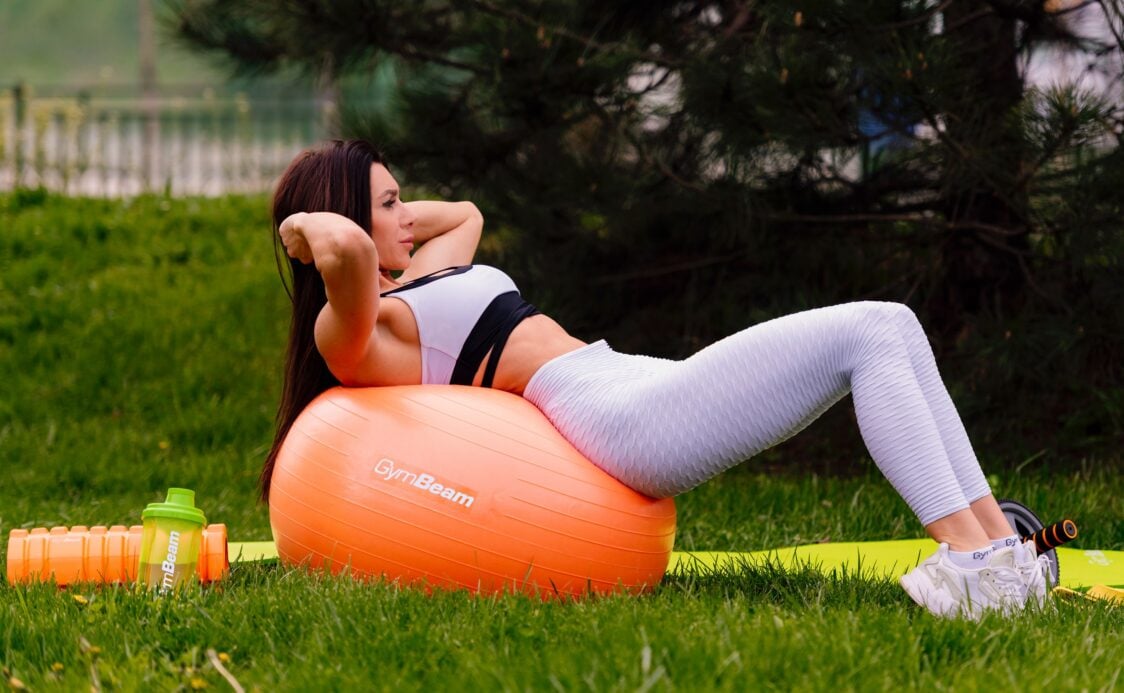
13 Effective Full-Body Exercises with an Exercise Ball
Just like with any workout, it’s advisable to do a light warm up and mobilize your entire body before the main part. When exercising with an exercise ball, it’s easy to lose balance, so pay attention to proper technique and perform all exercises slowly and in a controlled manner. Start with the basic variations and only increase the intensity later when you are confident in your abilities to execute the exercise.
1. Plank
- Starting Position: Create a plank with your arms extended, placing your hands approximately under your shoulders. Extend your legs, and position your feet, as well as your shins, on the ball. Brace your body, aiming to keep it in a straight line.
- Execution: Breathe freely, keep your body engaged, and try to maintain this position for at least 15 seconds. You can simplify the exercise by moving your hands closer to the ball, bringing it underneath your thighs.
- Advanced Variation: While holding the plank position, start alternately lifting your arms, touching the opposite shoulder each time.
- Common Mistakes: Arching your back, excessively lifting your pelvis.
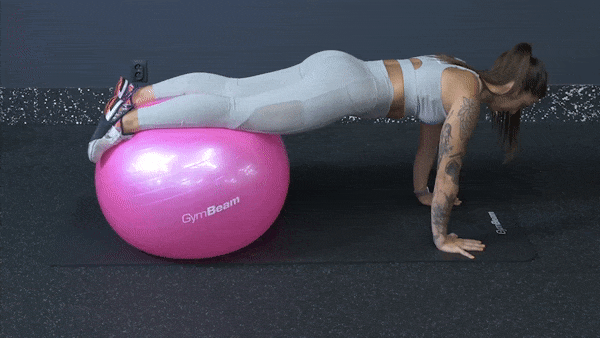
If you want to learn about the benefits of the plank exercise, check out the article: How Can the Plank Exercise Change Your Body? Six-Pack, Stronger Core and Better Athletic Performance
You might be interested in these products:
2. Oblique Crunch
- Starting Position: Lie on your back, bend your knees, and place your calves on the ball. Place your hands behind your head, with your fingers lightly touching it. Keep your elbows open.
- Execution: Exhale and engage your abdominal muscles to lift your head and upper back slightly off the ground to the side. At the same time, straighten one arm and reach it towards the opposite leg. The lower part of your back remains on the ground throughout. Then, inhale, return to the starting position and switch sides.
- Advanced Variation: Hold a weight plate or a small dumbbell with both hands in front of your chest and then try to bring it closer to one leg, and with the next repetition, to the other.
- Common Mistakes: Excessively pushing your hands into your head, limited range of motion, inadequate activation of abdominal muscles.
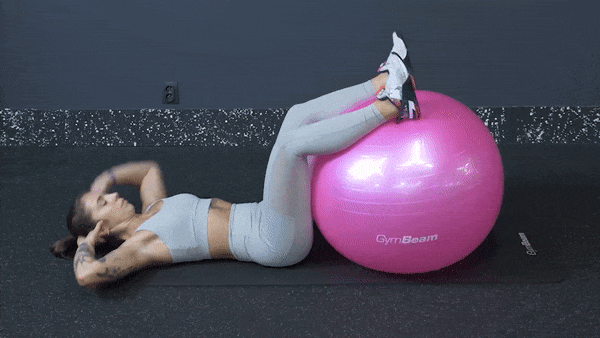
3. Twist
- Starting Position: Lie on the exercise ball with your back, bend your knees, and keep your feet on the ground. Extend your arms forward and join your palms. Activate your core.
- Execution: Exhale and do a rotation, turning onto your side. Then, inhale and return to the starting position, and continue by repeating the movement on the other side.
- Advanced Variation: Hold a weight, such as a small dumbbell, in your hands or put a weight on your wrists.
- Common Mistakes: Inadequate range of motion, uncontrolled movement.
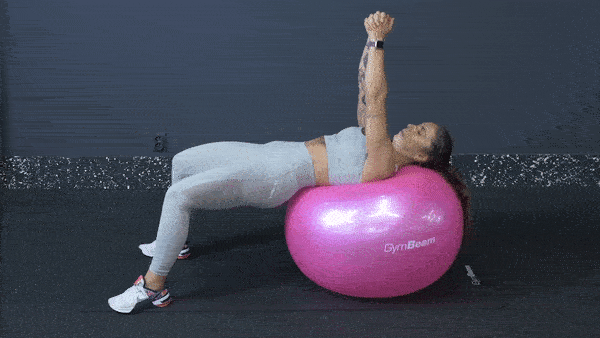
4. Reverse Crunch With Hips Up
- Starting Position: Lie on your back with the exercise ball between your ankles, and squeeze it firmly. Bend your knees, and place your arms beside your body. You can also position your hands under your buttocks from the sides; this will help you support the lower back better on the mat.
- Execution: Exhale, activate your abdominal muscles, lift the exercise ball up from the mat using your legs, and move it towards your head. During the upper phase of the movement, raise the lower part of your back and pelvis just a few centimetres above the ground. Then, inhale and carefully lower it back down, returning to the starting position. Follow this with another repetition.
- Advanced Variation: You can make the exercise more challenging by straightening your legs at the knees.
- Common Mistakes: Limited range of motion, inadequate activation of abdominal muscles, uncontrolled movement.
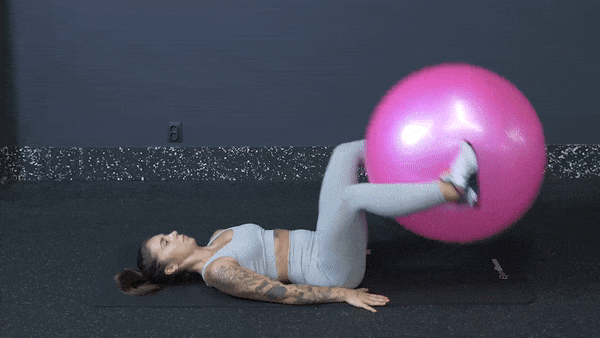
5. Hyperextension
- Starting Position: Place the ball about a meter away from a wall. Lie on it with your thighs, pelvis, and abdomen. Extend your legs, spreading them approximately a meter apart and bracing your feet against the wall. Bend your arms at the elbows, and you can place your joined palms either behind your head or in front of your forehead. Keep your head in line with your spine. Activate the core, back, and gluteal muscles.
- Execution: Exhale as you gradually lift your chest and upper abdomen off the ball. In the upper position, allow a slight arch in your back. You can include a 1-2-second hold at this point and then return to the starting position while inhaling. Immediately follow with another repetition.
- Advanced Variation: You can make the exercise more challenging by holding some weights in front of your chest with your hands, such as a weight plate, dumbbell, or a smaller kettlebell.
- Common Mistakes: Excessive arching in the back, uncontrolled movement.
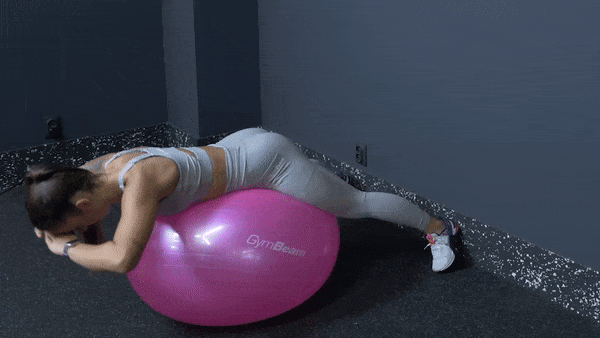
6. Lateral Pulldown
- Starting Position: Lie on the exercise ball with your upper thighs, pelvis, and abdomen. Anchor your feet by pointing the toes into the mat, keeping them extended and about a meter apart. Extend your arms upward, shoulders away from your ears, and keep your head in line with your spine. Activate the core, back, and gluteal muscles.
- Execution: Exhale as you draw your elbows towards your sides. Hold the bottom position for 1–2 seconds, and then inhale as you return to the starting position. Immediately follow with another repetition.
- Advanced Variation: Hold a resistance band or expander with both hands and pull it during the motion either in front of or behind your head.
- Common Mistakes: Excessive arching in the back, raised shoulders, uncontrolled movement.
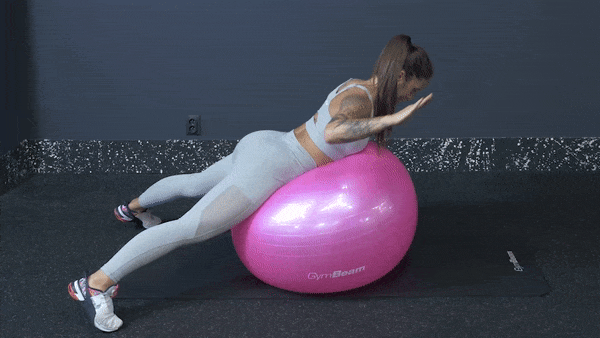
Discover our bestsellers:
7. Push-Ups
- Starting Position: Create a plank with your arms extended, placing your hands approximately under your shoulders. Extend your legs, and position your feet, as well as your shins, on the ball. Brace your body, aiming to keep it in a straight line.
- Execution: Bend your arms at the elbows and, with an inhalation, perform a push-up. Then, exhale as you push away from the ground, straighten your elbows, and return to the starting position. You can immediately proceed with another repetition. Throughout, ensure that your body remains in a straight line.
- Advanced Variation: The farther you place the ball from your hands, the more challenging the exercise becomes.
- Common Mistakes: Arching your back, inadequate range of motion.
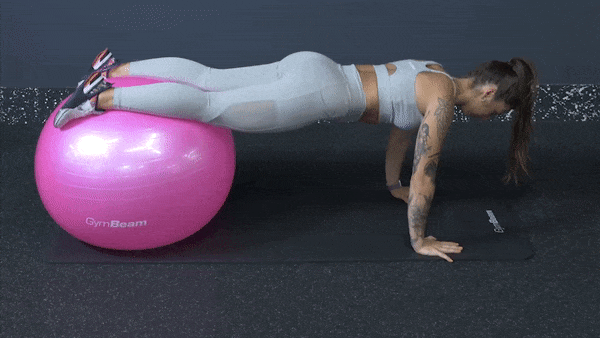
8. Triceps Extensions
- Starting Position: Kneel on the mat in front of the ball and lean on it with your forearms. Place your palms on the ball right next to each other, creating a triangle with your arms. Anchor the tips of your toes to the mat. Maintain the natural curve in your back and keep your head in line with your spine. Activate your core.
- Execution: Exhale as you push your palms into the ball and straighten your arms at the elbows. Then, proceed immediately with another repetition.
- Common Mistakes: Arching your back, limited range of motion.

9. Ball To Overhead
- Starting Position: Stand with your feet slightly apart, about shoulder-width. Hold the exercise ball with your arms extended, stand up straight, and keep it in front of your body. Pull your shoulders away from your ears.
- Execution: Activate your core and lift the ball with your arms extended above your head. Then, return it in front of your body and proceed with another repetition.
- Common Mistakes: Raised shoulders, inadequate range of motion.
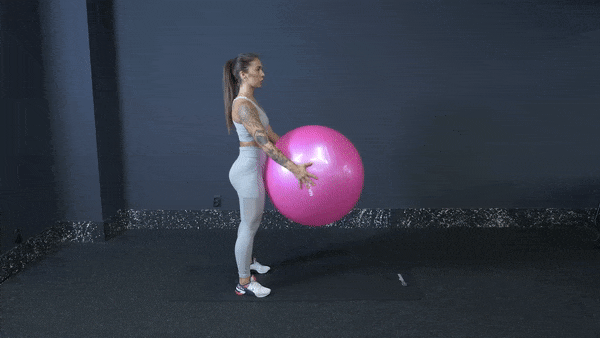
10. Hamstring Curl
- Starting Position: Lie on your back, extend your legs, and place your heels on the upper part of the exercise ball. Position your hands along your sides with your palms facing downward.
- Execution: Activate your gluteal muscles to lift your pelvis. Your head, upper back, and arms remain on the mat, serving as points of support. Roll the ball toward you by bending your knees and rolling your feet from heels to toes. Then, return it to the starting position by extending your knees and moving back from toes to heels. During the rolling movement, you should feel the engagement of the muscles on the back of your thighs. Your core is also working. Keep your pelvis up throughout the entirety of this exercise.
- Common Mistakes: Excessively arching your back, insufficient engagement of the glutes, thigh, or abdominal muscles, inadequate range of motion.

11. Wall Squat
- Starting Position: Place the ball against the wall, lift it to the height of your lower back, and lean against it. Stand with your feet hip-width apart and let your arms hang freely by your sides.
- Execution: While inhaling, bend your knees and perform a squat. In the lower position, try to go deep with your hips, going below knee level. Exhale, activate the muscles in your legs and glutes, and straighten back up. Then, proceed with another repetition.
- Advanced Variation: Hold a kettlebell or a dumbbell with both hands in front of your chest.
- Common Mistakes: Knees collapsing inward, inadequate range of motion.
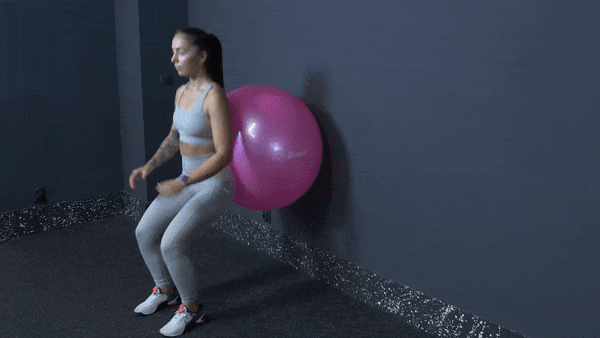
12. Reverse Lunge with Twist
- Starting Position: Stand upright with your feet hip-width apart and hold the exercise ball with both hands in front of your body. Activate your core.
- Execution: Inhale and do a backward lunge with one foot. Gently place the knee of the back leg on the mat and then, exhaling, perform a rotation with the ball to the opposite side. Then return to the starting position and perform the exercise on the other side.
- Common Mistakes: Limited range of motion, rounding your back.
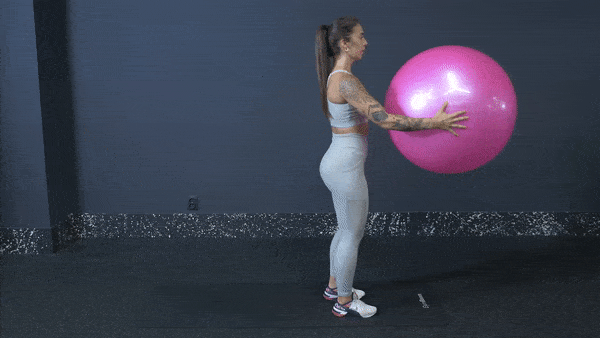
13. Single Leg Hip Thrust
- Starting Position: Lie on the exercise ball, bend your knees, and place your feet on the ground with your heels roughly under your knees. Position your arms beside your body and anchor your elbows into the ball as points of support. Keep your head a few centimetres above the ball, avoiding any excessive arching of your cervical spine.
- Execution: Exhale and activate your gluteal muscles to lift your pelvis while simultaneously raising one leg. In the upper position, you can include a 1-2-second hold, and then inhale as you return to the starting position. However, do not place your foot on the ground, instead, immediately proceed with another repetition. After completing one set, switch to the other leg. If this exercise is too challenging, you can keep both feet on the ground and only lift your pelvis.
- Advanced Variation: Place a dumbbell or other weight on your hips and start with the variation without lifting your legs. Then, with the utmost caution, attempt to add the leg lift.
- Common Mistakes: Inadequate range of motion, uncontrolled movement.
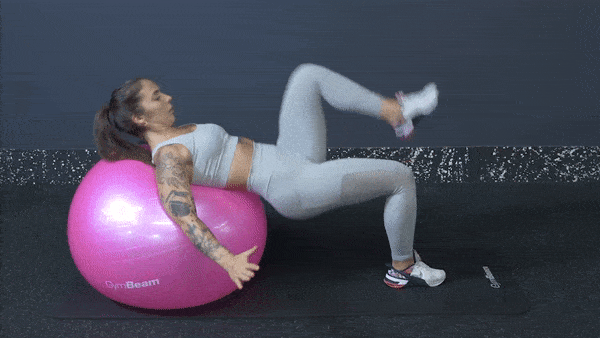
Where to look next?
- If you are looking for exercises with an exercise ball specifically designed for the abdominal area, you can find them in the article: 13 Best Exercise Ball Exercises for Strong Abs
- You can also create an effective abdominal and glute workout using the article: 10 Effective Core & Booty Exercises With Fit Ball
- Get an effective full-body workout with a balance half-ball. Effective exercises can be found in the article: 10 Best Balance Half-Ball Exercises to Improve Balance, Strengthen Your Back and Entire Body
- If you want to try a workout using just your body weight, you shouldn’t miss the article: Get in Shape With These 12 Bodyweight Exercises
- In case you want to exercise at home more often and need tips on how to get started and stay motivated, you can find guidance in the article: How to Start Exercising at Home and Stick With It? Simple Tips to Help You
What are the main takeaways?
Incorporating exercises with an exercise ball can be a great way to spice up your training routine, prevent stagnation, and achieve better results. They provide comprehensive strength training for your entire body, while also working on balance and coordination. You can find variations suitable for both beginners and advanced individuals, making them a valuable addition to anyone’s training plan. By gradually increasing the exercise intensity and adding more repetitions or sets, you’ll adhere to the principle of progressive overload, which is crucial for muscle growth and toning any muscle group. However, don’t forget about rest and a high-quality diet, as they are also essential for achieving results.
Was this article helpful to you? If so, share it with your friends and get them inspired for an exercise ball abs workout.
[1] Larsen, E. 4 Proven Benefits of Stability Ball Exercises: Science And Facts. – https://www.hometraininghero.com/benefits-stability-ball-exercises-science-behind-effectiveness/
[2] Yu, W., Cha, S., & Seo, S. The effect of ball exercise on the balance ability of young adults.– https://doi.org/10.1589/jpts.29.2087
[3] Srivastav, P., Nayak, N., Nair, S., Sherpa, L. B., & Dsouza, D. Swiss Ball Versus Mat Exercises For Core Activation of Transverse Abdominis in Recreational Athletes. – https://doi.org/10.7860/JCDR/2016/23102.8972

